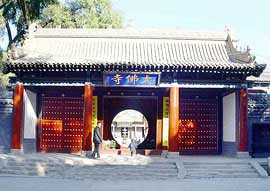| Legole.Com Discover china. Explore the beauty and wonder of the land, people, and culture of China. |
 |
|
|
 |
 Midway in the Hexi Corridor along the Silk Road lies the historic city of Zhangye, the centerpiece of which is the mysterious Giant Buddha Temple. Located in the southwest corner of Zhangye in Gansu Province, the Giant Buddha Temple is the largest architectural relic in Gansu Province of the Western Xia (1038-1227) period. China's largest reclining Buddha is well preserved in this temple. The Zhangye Museum is also located here. Midway in the Hexi Corridor along the Silk Road lies the historic city of Zhangye, the centerpiece of which is the mysterious Giant Buddha Temple. Located in the southwest corner of Zhangye in Gansu Province, the Giant Buddha Temple is the largest architectural relic in Gansu Province of the Western Xia (1038-1227) period. China's largest reclining Buddha is well preserved in this temple. The Zhangye Museum is also located here.
Legend has it that a chancellor named Wei Mie of the Western Xia period ordered workers to dig into the ground to 1 to 1.3 meters deep to carve a reclining Buddha to be covered with glazed color tiles. The Giant Buddha Temple was built in 1098 to house the Buddha. In its 900 years the temple was restored many times during the Ming and Qing dynasties.
The existing complex consists of the Giant Buddha Hall, the Buddhist Classics Hall, and a Clay Pagoda. The two-storied Giant Buddha Hall is 33 meters high, 49 meters wide and 24 meters long, with a total area of 1770 square meters. The gold-plated and painted Giant Buddha lies in the Nirvana situation in the middle of the hall. The whole Buddha is 34.5 meters long and 7.5 meters wide between its two shoulders, with feet of 4 meters and ears of 2 meters. The Buddha's calm expression moves visitors. Behind the Buddha are 10 disciples, and in two side halls stand 18 Saintly Warriors. The walls of the hall are covered with colorful murals, which depict episodes from the Mountain-sea Sutra (an ancient Chinese encyclopedia) and from Journey to the West (a celebrated novel written in the Ming Dynasty).
In the Buddhist Classics Hall, there are more than 6000 tomes of lectures, some of which, written in gold and silver, are the rarest and most precious.
The Clay Pagoda, one of the Five Elements Pagodas in Zhangye, has 13 stories, on the first and the second stories of which are four miniature pagodas, a feature rarely seen in other pagodas.
It is said that the Bieji Queen (a famous queen of the Yuan Dynasty) once lived in the Giant Buddha Temple, giving birth to Kublai Khan there. The Italian traveler Marco Polo, impressed by the magnificent architecture of the Giant Buddha Temple and by the prosperity of Zhangye city, lived here for more than a year.
Magnificent, mysterious, and unique, the Giant Buddha Temple belongs on every visitor's itinerary.
Admission Fee: RMB 22
Opening Hours: 07:30 to 17:30
Recommended Time for
a Visit: One Hour |
 |
|
|
 |
|
